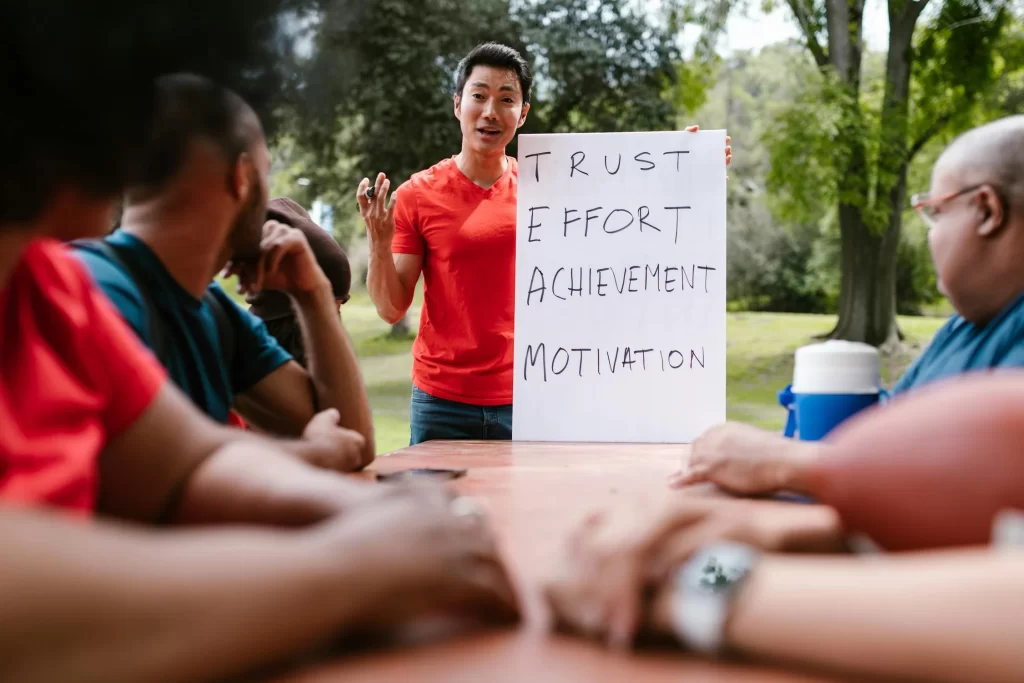Learning And Development Interventions in the Philippines
Learning and development interventions in the Philippines (L&D) refers to the structured programs and activities designed to enhance employees' skills, knowledge, and competencies within organizations.
These interventions are essential in addressing the specific needs and challenges of the workforce as well as the organizational objectives, creating and developing a culture of continuous learning and adaptation in a rapidly changing business environment.
Top Learning And Development Interventions in the Philippines
This list covers the top learning and development interventions in the Philippines and has been constantly updated to fit into the current learning needs of employees today. Here’s an overview of the top L&D interventions:
In-House Training Programs
Many Philippine organizations design in-house training sessions specifically tailored to their operational needs. These may include technical skills development like sales training and skills enhancement like leadership training.
Most L&D practitioners categorize in-house training programs into hard skills and soft skills - but today, they now call soft skills “core skills.”
Hard skills are technical skills that address the competencies of individuals for a specific task or job. For example, sales training programs are designed to elevate the closing rates and prospecting efficiency of salespeople within the organization. It addresses the performance gap between their current sales quota and their desired performance.
Soft skills, often called core or interpersonal skills, are non-technical abilities related to working and interacting with others. Unlike hard skills, which are about a person's skill set and ability to perform specific tasks, soft skills are more about behavior and thinking, personal traits, and cognitive skills. They are crucial for building relationships, gaining visibility, and creating more opportunities for advancement.
Online Learning and Blended Learning Platforms
With the digital transformation in the Philippines, many companies have adopted online and hybrid learning to provide their employees access to a wide range of courses and training materials.
This type of learning intervention enables flexible learning schedules and a broader array of topics.
Blended learning is an educated approach that combines traditional face-to-face classroom instruction with online learning and independent study. Participants can learn at their own pace and time while still experiencing a high-quality learning environment.
Mentorship Programs
Some organizations in the Philippines implement mentorship programs where experienced consultants, trainers, and professionals guide their less experienced employees.
Mentorship programs are typically one-way communication, where they help employees develop their skills and better understand the organizational mission, vision, and culture.
Most companies we’ve trainers in my corporate training company have created specialty mentorship programs for their managers and leaders - as these have a higher need for mentorship (e.g., thinking styles and skills).
Continuous Leadership Development Programs
As I’ve observed with Filipino companies as a trainer-consultant, some multinational companies create in-house leadership development programs to address continuous succession planning of leaders, new and transitioning managers, and supervisors and develop their existing managers.
Continuous leadership development programs start by identifying their leadership and development strategy, which include the following:
- Vision of the organization they support (it must support the company's overall vision in the current year).
- Leadership competencies (specific areas of leadership and management they want to highlight in their programs).
- Success measures (identified KRAs - Key Responsibility Areas and KPIs - Key Performance Indicators).
- Learning Journey (types of learning, and if it includes pre-training and post-training)
- Specifics of leadership development program (training schedule, objectives for each program, etc..).
In the Philippine context, leadership development programs are now an integral learning and development intervention and not just part of a soft skills training program.
Team Development
Often known as team building, team development is a learning and development intervention designed to address the pressing need for bridging alignment within an organization. Some are helping organizations to be more effective through interpersonal processes.
Team development (“team building”) can be categorized into three facets:
- Team alignment - for established teams but lacking understanding and applying culture alignment (as well as goal alignment) within each other. It aligns (as it calls it) teams within organizations to a common purpose, vision, or goals.
- Team bonding enhances professional relationships among participants to minimize or avoid conflicts and allow for better harmony and dynamics among teams.
- Team building helps unite employees within teams and creates a better work culture, which can lead to progress in performance and culture alignment.
Executive Coaching
Executive coaching is a learning and development intervention for senior leaders and the C-Suite of the organizations. It addresses their day-to-day challenges as they lead the entire organization.
Given their strict, busy schedules, executive coaching allows senior leaders and executives flexibility. It is an ongoing program to help unlock the potential of these high-level professionals to elevate their work performance and move the organization forward.
On-the-Job Training
On-the-job training is a practical approach to learning where employees learn by doing. They work on actual tasks under the supervision of a mentor or a supervisor, which helps them acquire job-specific skills and knowledge.
Observation is integral to this learning intervention as the observer (manager/supervisor) assesses the employee’s current job knowledge, skills, and attitude toward the given task/job.
Succession Planning
Succession planning involves preparing employees to take on critical roles within the organization in the future. It included a combination of training, shadowing, and mentoring - and, to some extent, a development program to allow the organization to create a pipeline of capable leaders.
Cultural Sensitivity Training
Given the Philipines' diverse culture andthe many organizations now working with professionals outside the country, some organizations provide training to help their employees understand and respect different cultural backgrounds, enhance teamwork, and reduce workplace conflicts.
In today’s learning and development, we call it “cultural intelligence” - connecting and adjusting to other people’s cultures to promote unity and achieve organizational goals.
These learning interventions areal for individual employees' growth andgnificantly to organizational success by aligning employee skills with the company’s strategic goals.
Leadership Training Programs in the Philippines
Leadership training programs are essential in driving business performance and sustaining growth.
Here is our curated list of leadership training programs for employees in the Philippines. We categorize it based on levels and development so you can see what fits your current learning and development or training plan.
Leadership Training Programs (By Level)
Leadership Training for Transitioning Managers
- Fundamentals of Leadership - This training program helps your transitioning leaders understand the different leadership styles, the role of a manager, and tips and strategies in transitioning from peer to manager job. Invest in our leadership training.
- People Management: It focuses on motivating teams, delegation, performance management, and giving effective feedback. These are the essential skills of a manager.
- Communication Skills: This training program is designed to help participants develop effective communication strategies, active listening, and conflict resolution. See our communication skills training.
- Change Management: A modern-day leadership training program focused on teaching strategies for managing change within a team, adapting to the ever-changing work environment and industry, managing effectiveness in transitioning to new roles, and guiding teams through transitions. Develop your people with change management training.
Leadership Training for Managers and Supervisors
- Strategic Thinking: The program speaks on developing and implementing strategic plans based on organizational and department goals, with strategies for decision-making processes and innovation management. See our strategic thinking training.
- Advanced People Management: This program leans toward cultivating high-performance teams, advanced conflict resolution, and managing diverse teams. Invest in leadership and management training.
- Leadership Ethics: A rarely discussed training program, but it is vital in today’s rapidly changing world. This leadership program focuses on understanding ethical leadership, corporate social responsibility, and creating an ethical workplace culture within your teams.
- Coaching and Development: This is an introductory course to develop skills in coaching for performance and succession planning (for multiple leadership roles in the company).
Leadership Training for Senior Leaders and Executives
- Visionary Leadership: A leadership training program to help senior leaders develop a compelling vision, strategic alignment, and execution through the vision - all these are vital in directing an organization to the next level of growth.
- Influence and Negotiation: A technical-based leadership program teaches leaders and executives about influencing others, negotiation skills, and stakeholder management.
- Executive Decision Making: The majority of executives' work deals with decision-making. Having a suitable framework or set of values to consider can help increase the likelihood of making significant decisions for the company - this now involves risk management and critical thinking at the executive level. See our executive leadership training.
- Leading Organizational Change: A leadership training program in executing strategies for leading large-scale change, transformational leadership, and change resilience.
Leadership Training Programs (By Development)
Personal Leadership
This level of development for leadership training programs focuses on self-awareness and self-management as the foundation of effective leadership. Personal leadership should be considered a core skill (not just a “soft skill”) nowadays. Participants will learn to understand their leadership styles, values, and strengths and how all these can influence their interactions and decision-making for their teams.
Here are some of the top training programs for personal leadership.
- Strategic Thinking: This training helps leaders develop the ability to think strategically, adapt to changes, anticipate future consequences and trends, and consider the broader impact of their decisions. It involves understanding the organization's vision, setting long-term goals, and developing plans to achieve them. Learn more about our strategic thinking training.
- Critical and Creative Thinking: This leadership training program helps participants enhance leaders' ability to analyze complex problems, generate new solutions, and make decisions under uncertainty. It may involve learning different creative thinking and problem-solving frameworks, logical reasoning, and innovative thinking to address challenges creatively and effectively.
- Leadership Essentials: A foundational personal leadership program that covers the critical aspects of effective leadership, including business ethics, discipline, setting direction, inspiring others, driving change, and delivering results. It's designed for new or aspiring leaders to build core leadership skills.
Leading Others
This developmental leadership training course focuses on interpersonal aspects of leadership, such as inspiring teams, influencing and leading even without authority, and building productive relationships. It's about guiding others toward shared goals while fostering organizational collaboration and commitment.
- Coaching and Mentoring: In this Leading Others program, participants should learn how to develop others through coaching and mentoring, which provide guidance, feedback, and support to help individuals grow their skills, improve performance, and achieve their career objectives. It may consist of coaching frameworks that leaders can use to coach their direct reports. Learn about coaching and mentoring training.
- Introduction to Performance Management: This leadership training program introduces leaders to the principles and practices of effective performance management, including setting clear expectations, monitoring performance, and conducting performance evaluations. The corporate trainer may include frameworks they use to help other companies, or they can integrate an in-house (what has been used) by their target client and enhance it during the training. Invest in performance management training.
- People Handling Skills: This training helps leaders learn more about techniques to manage diverse personalities, resolve conflicts, and handle difficult conversations. This training is essential for building a harmonious and productive workplace. See our people handling skills training.
- Feedback Giving: This leads the other programs to focus on the art and science of providing constructive feedback to encourage development and improve performance. Leaders learn how to deliver feedback in a clear, specific, actionable, and sustainable way.
- Team Performance 101: This training covers the fundamentals of building and leading high-performing teams, including team dynamics, collaboration, and leveraging the strengths of team members to achieve common goals. Different frameworks, such as those by Dr. John Maxwell, a leadership guru on teamwork 101, can help trainers develop a solid team performance course. Build your teams with our high performing team training.
- Inclusive Leadership: This leadership training program addresses the importance of diversity and inclusion in the workplace (we call it a DIBER training program (Diversity, Equity, Inclusion, and Belonging). Leaders will understand and apply strategies to create an inclusive environment where all team members feel valued and can contribute to their fullest potential. See our inclusive leadership training.
- Situational Leadership: This approach teaches leaders to adapt their style based on the situation and the needs of their team members. It emphasizes flexibility and the ability to diagnose the circumstances and respond with the most appropriate leadership behavior. With frameworks from Ken Blanchard (4 situation leadership styles framework) or Dan Goleman (on emotional intelligence), you can develop a training program to help your leaders identify their situational leadership styles and apply them to their workforce. Invest in our situational leadership training.
Rainmakers As A Leadership Training Provider
We’ve covered enough of a list of training programs for different employee levels and development. You can check out our full list of training programs for employees in the Philippines.
If you need a leadership training provider, send us your training requirements so we can schedule a training needs analysis session with your team.
Venchito Tampon, the founder and lead trainer of Rainmakers, has been speaking with and training thousands of leaders in the Philippines and Southeast Asian countries. We develop customized and personalized leadership training programs to suit the developmental needs of your employees.
List Of Training Programs For Employees In The Philippines
Building your employees’ competencies is an integral part of your organization's learning and development facet.
If you’re wondering what types of training programs are helpful in today’s day and age and help close the performance gaps. Here is our curated list of training programs for employees in the Philippines.
We categorized it based on ranks or levels, so you can easily see the difference for broad training programs (i.e., leadership training programs).
List of Training Programs (By Level)
Entry-Level and Rank-and-File:
- Customer Relationship Management: This training is designed to build and maintain positive relationships with customers, to know their deep desires and concerns, and to serve them to increase satisfaction and loyalty.
- Conflict Resolution: A training course on discovering techniques for resolving workplace conflicts and promoting a healthy collaborative environment.
- Digital Literacy: Training to develop skills in utilizing digital tools and platforms, essential in modern-day work environments.
- Success Training: A training to elevate self-inspiration and discipline to meet employees’ personal and professional goals, fostering a mindset geared towards individual and organizational success. See our success training.
- Productivity and Workload Management Training: Help your employees learn how to manage workload efficiently, prioritize tasks, and improve productivity. Invest in our productivity training.
- Mental Health: A training that brings awareness and strategies to maintain well-being, stress management, and foster a healthy work-life balance or harmony.
Mid-Level Management:
- Emotional Intelligence: A training to enhance the ability to perceive, use, and manage emotions positively to relieve stress, communicate effectively, and empathize with others (colleagues). Check out our emotional intelligence training.
- Problem Solving and Decision Making (PSDM): A training to develop critical thinking and problem-solving skills to make informed, wise, and effective decisions at work. See our PSDM training.
- Effective Business Communication: A training to enhance clear and compelling business communication, both internally and externally, that will help improve interpersonal and presentation skills. Know more about our business communication training.
- Basic Leadership Training: This is training to learn and acquire fundamental leadership skills, including how to motivate team members, make ethical decisions, and inspire trust among teams. See our basic leadership training.
- Leadership Mentoring and Coaching: A training for mentoring and coaching team members, fostering team development, and building leadership pipelines within the organization. Learn more about our coaching and mentoring training.
- Giving Feedback: A training to develop skills for providing constructive feedback to promote professional growth and performance improvement.
- Change Management: A training to prepare leaders to guide their teams through change, addressing resistance, and ensuring successful implementation of new initiatives.
- Strategic Thinking: A training to help cultivate the ability to think strategically, plan long-term, and anticipate future challenges and opportunities. See our strategic thinking training.
- Cross-Cultural Competence: A training to help employees understand and navigate cultural differences within the workplace to enhance communication and team cohesion in diverse environments. This is mainly done in training for global or multi-national companies.
Senior Management and Executives:
- Executive Presence: A training to help build the charisma, confidence, and clarity employees need to command respect and inspire confidence in others.
- Executive Leadership: A training to help leaders gain advanced leadership skills to drive the organization’s vision, make strategic decisions, and foster a robust organizational culture. Build skills with our executive leadership training.
- Business Strategy: A training course on developing and implementing robust strategies to guide the organization's direction and ensure its competitiveness in the market.
- Succession Planning: A training to prepare senior leaders for leadership transitions, ensuring the organization’s resilience and continuity by identifying and developing future leaders.
- Innovation Management: A training to foster an innovative culture, manage the creative process, and implement innovation strategies for growth and competitiveness. Invest in our innovation management training.
- Global Leadership: A training to help senior leaders lead across borders, understand global market dynamics, and manage across cultures.
List of Training Programs (By Skills Development)
Sales and Marketing Training:
- Fundamentals of Sales: A training course to help sales agents understand the value and foundational principles of selling, understand customers' needs, and develop compelling sales pitches. See our sales training.
- Advanced Sales Techniques: A training to enhance one’s negotiation skills, relationship building, and closing sales. This training leans towards the second half of the pipeline process (up to closing deals).
- Strategic Selling: A training to help salespeople develop strategies to tap different market segments and manage sales pipelines more effectively.
- Digital and Social Media Sales Strategies: A training to help sales teams utilize digital platforms to generate leads and close deals.
- Digital Marketing Skills: A training designed to help marketers and salespeople understand and apply strategies in SEO, PPC, social media marketing, content marketing, and email marketing to enhance their brand’s online presence and digital reach. Invest in our digital marketing training.
- Market Research and Analysis: This is training to develop skills in gathering, analyzing, and interpreting market data to make informed marketing decisions.
- Brand Management: A training to help marketers focus on building and maintaining a solid brand, understanding brand positioning, and managing brand equity.
- Customer Engagement and Relationship Management: A training to help front-liners learn and apply strategies to engage customers, improve customer experience, and build long-lasting relationships with stakeholders.
- Strategic Marketing Planning: A training to acquire skills in developing comprehensive marketing strategies that align with business objectives and adapt to changing market conditions.
Negotiation Training:
- Essential Negotiation Skills: A training to help employees in procurement and supply chain management understand the fundamentals of negotiation, including preparation, communication techniques, and closing agreements. See our negotiation skills training.
- Advanced Negotiation Techniques: A training on complex negotiation strategies, handling objections, and multi-party negotiations.
- Negotiating in High-Stakes Environments: A training designed to learn how to handle high-pressure negotiation scenarios and large-scale deals.
- Cross-Cultural Negotiation Skills: A training to help individuals adapt negotiation strategies to different cultural contexts and global environments.
Customer Service Training:
- Customer Service Essentials: A training to understand the core principles of customer service, including empathy, active listening, and problem resolution. Invest in our customer service training.
- Handling Difficult Customers: A training to cultivate and apply strategies for managing challenging interactions and turning negative experiences into positive outcomes. Best for customer service representatives or personnel.
- Enhancing Customer Experience: Training new and experienced customer service personnel (or frontline workers in the hotel and hospitality industry) to learn techniques to exceed customer expectations and foster loyalty.
- Customer Service in a Digital World: A training to help target participants adapt customer service practices for digital communication channels.
Communication Skills Training:
- Effective Interpersonal Communication: A training to help elevate verbal and non-verbal communication skills, enabling employees to express ideas clearly and foster better workplace relationships.
- Public Speaking and Presentation Skills: This training is designed to improve confidence and clarity in public speaking. It covers structuring content presentations, engaging the audience through proper delivery, crafting stories that resonate with them, and effectively conveying messages. Learn more about our public speaking training.
- Non-Verbal Communication Mastery: A training that teaches the interpretation and use of body language, facial expressions, and other non-verbal cues to enhance communication effectiveness.
Time Management Training:
- Prioritizing and Goal Setting: A training to introduce strategies and methods for setting achievable goals and prioritizing tasks to enhance efficiency and productivity. Participants can harness productivity and goal-setting skills during the training using the Eisenhower Framework or Michael Hyatt’s Free T of Focus. Invest in our goal setting and action planning training.
- Overcoming Procrastination: A training that offers strategies to identify and overcome procrastination habits, fostering a more proactive work approach.
- Time Management Tools and Techniques: A training introducing various tools and techniques to manage time effectively, enhancing personal and team productivity. In our productivity training, we introduce our Simplify Framework to teach our target principles with basic task management principles and strategies.
Problem-Solving Training:
- Creative Problem Solving: This training focuses on developing creative approaches to problem-solving and encouraging innovative thinking and solutions.
- Critical Thinking Skills: A training to enhance the ability to analyze information, identify biases, and make reasoned decisions.
- Decision Making Under Pressure: A training to help prepare individuals to make quick, effective decisions in high-pressure situations.
Project Management Training:
- Basics of Project Management: A training to help cover fundamental project management principles, methodologies, and tools.
- Agile and Scrum Methodologies: A training to introduce Agile and Scrum frameworks, focusing on flexibility and team collaboration.
- Risk Management in Projects: A training for methodologies to identify, assess, and manage risks in project settings.
Human Resources Skills Training:
- Recruitment and Selection Techniques: A training to help HR practitioners learn and apply effective strategies for attracting, selecting, and retaining the right talent.
- Employee Engagement Strategies: Training for HR and OD (Organizational Development) professionals on boosting employee engagement, satisfaction, and productivity.
- Diversity and Inclusion Training: This training focuses on creating an inclusive workplace, understanding diversity issues, and promoting equity.
- Training Needs Analysis - Training to teach trainers and OD professionals conduct training needs analysis as the initial phase in creating training programs for their employees. See our training needs analysis training.
- Train the Trainers - This training is specifically designed for employees conducting training programs, from training needs analysis to training evaluation. Invest in our train the trainers training.
If you’re looking for a partner learning and development outsourcing or training provider, contact us for a free quote or list of our training programs.
Leadership and Employee Engagement: Strategies for Boosting Motivation and Productivity
Leadership and employee engagement is a management approach focused on cultivating a work environment where employees are emotionally invested in their work and committed to the goals and values of the organization.
It involves fostering open communication, providing support and resources, recognizing achievements, and empowering employees to contribute their best efforts.
Effective employee engagement leadership aims to create a positive workplace culture that encourages collaboration, innovation, and overall job satisfaction among team members.
How Leaders Impact Employee Engagement
Leaders play a pivotal role in shaping the dynamics of employee engagement within an organization. Their influence extends across various dimensions of the workplace environment, directly impacting employees' commitment, motivation, and overall job satisfaction.

Here's a detailed look at how leaders influence employee engagement:
Setting the Tone for Organizational Culture
- Role Modeling: Leaders exemplify the behaviors and attitudes they expect from their team members. By demonstrating commitment, integrity, and enthusiasm, leaders set a standard and create a culture that encourages engagement.
- Building Trust: Transparent and honest communication fosters an environment of trust. Leaders who are open about their decisions, acknowledge challenges and share successes make employees feel valued and integral to the organization.
Fostering a Sense of Belonging and Purpose
- Vision Communication: Leaders articulate a clear and compelling organizational vision. When employees understand how their roles contribute to broader organizational goals, they are more likely to be engaged and motivated.
- Inclusivity and Diversity: Promoting an inclusive workplace where diverse perspectives are valued enhances leadership and employee engagement. Leaders who recognize and celebrate diversity foster a sense of belonging among employees.
Enhancing Employee Growth and Development
- Professional Development: Leaders who invest in their employees' growth through training, mentorship, and career advancement opportunities show that they value their team's long-term success, boosting engagement.
- Feedback and Recognition: Constructive feedback and recognition of achievements affirm employees' efforts and talents, reinforcing their engagement and commitment to the organization.
Creating a Supportive and Collaborative Environment
- Empowerment: By delegating responsibility and offering autonomy, leaders empower employees, encouraging initiative and innovation and enhancing engagement.
- Team Dynamics: Leaders who nurture positive team dynamics and collaboration create an environment where employees feel supported and more engaged.
Ensuring Well-Being and Work-Life Balance
- Attending to Well-being: Leaders who prioritize the well-being of their employees through supportive policies and resources ensure that employees feel taken care of, fostering engagement.
- Promoting Work-Life Balance: Acknowledging the importance of balance and providing flexibility where possible helps employees manage their personal and professional lives, enhancing their engagement and loyalty.
Leveraging Effective Communication
- Active Listening: Leaders who actively listen to their employees' ideas, concerns, and feedback create a culture of respect and mutual engagement.
- Consistent Communication: Regular and clear communication about organizational changes, challenges, and successes keeps employees engaged.
Corporate Training and Employee Engagement
Corporate training enhances leadership and employee engagement by equipping team members with the skills and knowledge necessary to excel in their roles and contribute meaningfully to the organization's objectives.
Effective corporate training programs are about professional development and signaling the company's investment in its employees' growth and success.
Employees who receive relevant, high-quality training feel more competent and confident in their abilities, directly impacting their engagement and productivity. Training programs tailored to meet employees' specific needs and aspirations resonate more, showing them that the organization values their individual growth and career progression.
Corporate training fosters community and shared purpose among employees. Collaborative training sessions, workshops, and team-building activities enhance social connections and encourage teamwork, further boosting engagement. Organizations facilitate a learning culture by making employees feel part of a dynamic and evolving workplace.
Ongoing training opportunities allow employees to stay abreast of industry trends and innovations, which can invigorate their interest and enthusiasm for their work. When employees see a clear path for advancement and feel equipped to tackle new challenges, their commitment to the organization strengthens.
Corporate training is a pivotal engagement tool that enhances employees' skills and knowledge and demonstrates the organization's commitment to their development and well-being.
A well-designed training program can significantly impact employee motivation, satisfaction, and loyalty, fostering a more engaged and productive workforce.
How to Measure Employee Engagement
Measuring employee engagement is crucial for organizations to understand how invested their employees are in their work and the company's success. It involves assessing various key behavioral indicators that collectively provide a comprehensive view of the engagement levels within the workforce.
Here are some critical aspects to consider when measuring employee engagement:
Survey Responses: Utilizing employee engagement surveys with carefully crafted questions can provide deep insights into how employees feel about their work, the organization, and their place within it. These surveys should include questions that gauge employees' satisfaction, commitment, motivation, and sense of belonging.
Absenteeism and Turnover Rates: High absenteeism and turnover rates can indicate low employee engagement. Engaged employees are generally more consistent in attendance and less likely to leave the organization. Monitoring these metrics can provide valuable clues about the overall engagement levels.
Productivity Levels: Productivity metrics are a direct indicator of engagement. Engaged employees are typically more productive, motivated, and committed. Measuring output, quality of work, and efficiency can help assess employees' engagement.
Participation in Training and Development: Engaged employees are likelier to participate in training and development opportunities. Their willingness to learn and grow within the organization reflects their engagement and commitment to their professional development and the company's success.
Employee Advocacy: Engaged employees are more likely to speak positively about the organization, acting as brand ambassadors. Their willingness to recommend the company to friends or on their social networks as a great workplace strongly indicates their engagement.
Innovation and Initiative: Engaged employees often exceed their essential job responsibilities. They are more likely to contribute ideas, seek improvements, and show initiative in problem-solving, demonstrating their investment in the company's success.
Employee Interaction and Collaboration: Observing how employees interact and collaborate can provide insights into their engagement levels. Engaged employees are typically more communicative, cooperative, and enthusiastic about participating in team activities.
By closely monitoring these key behavioral indicators, organizations can gain valuable insights into employee engagement levels. This understanding enables leaders to identify improvement areas and design targeted strategies to enhance engagement, fostering a more motivated, committed, and productive workforce.
The Role Of Technology In Employee Engagement Leadership
Technology is crucial in enhancing employee engagement in the contemporary workplace, acting as a catalyst that bridges the gap between leadership and the workforce. It offers innovative solutions enabling leaders to foster a more engaged and connected team despite challenges in remote or hybrid work environments.

Technology facilitates streamlined communication, ensuring leaders effectively convey goals, feedback, and recognition in real-time. Tools like instant messaging, video conferencing, and collaborative platforms enable transparent and consistent interactions, which are fundamental for building trust and engagement. They allow leaders to maintain a pulse on the team's morale and provide a platform for employees to voice their ideas and concerns.
Technology enhances the personalization of employee experiences. Data analytics and AI can help leaders understand individual employee preferences, performance patterns, and engagement levels. This insight enables tailored approaches to motivation, learning, and development, making employees feel valued and understood.
Learning and development are further revolutionized by technology, offering employees opportunities for growth and advancement at their fingertips. E-learning platforms, virtual workshops, and webinars facilitate continuous learning and skill development, critical drivers of engagement. Leaders can leverage these tools to create a culture of continuous improvement and career progression.
Employee recognition has also been transformed by technology. Digital platforms enable instant and public acknowledgment of employees' contributions, amplifying the impact of recognition on engagement. Such systems can integrate with the organization's workflow, allowing leaders and peers to recognize efforts seamlessly fostering a culture of appreciation.
Technology supports employee well-being initiatives, a vital component of engagement. Apps and platforms that promote mental health, physical wellness, and work-life balance demonstrate the organization's commitment to the holistic well-being of its employees, which is crucial for sustaining engagement.
Technology empowers employees by giving them a voice. Engagement surveys, feedback tools, and suggestion boxes facilitated by tech platforms provide leaders with invaluable insights into the workforce's sentiments and ideas, enabling responsive leadership that aligns with employees' evolving needs.
In essence, technology in employee engagement leadership is not just about digital tools and platforms; it's about creating a more interactive, responsive, and personalized work environment. By integrating technology thoughtfully, leaders can cultivate a culture of engagement where employees feel connected, valued, and motivated to contribute to their fullest potential.






